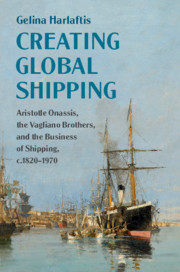 Creating Global Shipping
Creating Global Shipping Book contents
- Creating Global Shipping
- Cambridge Studies in the Emergence of Global Enterprise
- Creating Global Shipping
- Copyright page
- Dedication
- Contents
- Figures
- Maps
- Tables
- Preface
- Acknowledgments
- Abbreviations
- Introduction
- 1 The European and Greek Shipping Firm
- 2 The Vagliano Shipmasters
- 3 An International Trading House from Russia to the United Kingdom, 1850s‒1880s
- 4 The Russian Government v. Mari Vagliano, 1881–1887
- 5 The Vagliano Fleet and Innovation in Ship Management
- 6 Merchant to Shipowner
- 7 The Onassis Fleet, 1946–1975
- 8 The United States Government v. Aristotle Onassis, 1951–1958
- 9 Innovation in Global Shipping: The Onassis Business, 1946–1975
- 10 Diachronic Presence
- Select Bibliography
- Appendices
- Index of Names
- Index of Places
- Index of Terms
1 - The European and Greek Shipping Firm
Published online by Cambridge University Press: 19 August 2019
- Creating Global Shipping
- Cambridge Studies in the Emergence of Global Enterprise
- Creating Global Shipping
- Copyright page
- Dedication
- Contents
- Figures
- Maps
- Tables
- Preface
- Acknowledgments
- Abbreviations
- Introduction
- 1 The European and Greek Shipping Firm
- 2 The Vagliano Shipmasters
- 3 An International Trading House from Russia to the United Kingdom, 1850s‒1880s
- 4 The Russian Government v. Mari Vagliano, 1881–1887
- 5 The Vagliano Fleet and Innovation in Ship Management
- 6 Merchant to Shipowner
- 7 The Onassis Fleet, 1946–1975
- 8 The United States Government v. Aristotle Onassis, 1951–1958
- 9 Innovation in Global Shipping: The Onassis Business, 1946–1975
- 10 Diachronic Presence
- Select Bibliography
- Appendices
- Index of Names
- Index of Places
- Index of Terms
Summary
This chapter follows the evolution of European shipping business by focusing on the Greek experience. There are four distinct stages in the evolution of the European shipping firm 1) up to the 1820s; 2) from 1830s to 1870s; 3) from 1880s-1930s; and 4) 1940s-1970s. Greek shipping firms in general followed the development of their European counterparts; this was the context in which the Vaglianos and Onassis shipping firms developed. Their success lay to a large extent in the fact that they were family businesses that retained an important connection to specific island maritime communities preserving a unique maritime cultural tradition. The Vagliano’s case indicates how from the first stage of the evolution of the sailing shipping firm they made the transition to the second stage of the international trading firm and then led the way in the third stage, to the formation of a ship management firm. The Onassis case indicates how from the third stage of the ship management firms a great leap forward was made towards the fourth stage: the creation of the new form of global maritime business in the second half of the twentieth century.
Keywords
- Type
- Chapter
- Information
- Creating Global ShippingAristotle Onassis, the Vagliano Brothers, and the Business of Shipping, c.1820–1970, pp. 14 - 41Publisher: Cambridge University PressPrint publication year: 2019


